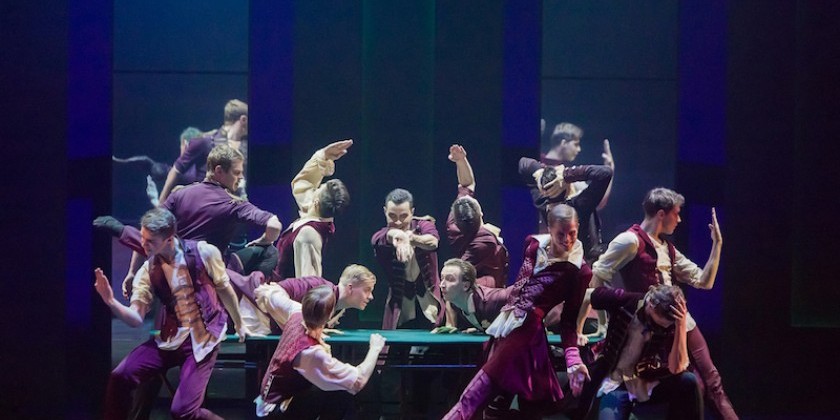IMPRESSIONS: Eifman Ballet of St. Petersburg in Boris Eifman's "Tchaikovsky: Pro et Contra" at New York City Center

June 9, 2017
New York City Center
Choreography: Boris Eifman
Music: Pyotr Tchaikovsky
Sets: Zinovy Margolin
Costumes: Olga Shaishmelashvili, Vyacheslav Okunev
Light Design: Alexander Sivaev, Boris Eifman
A bed occupies center stage, at the start of Boris Eifman’s ballet Tchaikovsky: Pro et Contra, which the Eifman Ballet of St Petersburg performed at New York City Center on June 9. No wonder. The ballet, a jolting psycho-drama, reformulates provocative ideas about this composer’s homosexuality that Eifman first expressed in 1993, under the title Tchaikovsky: the Mystery of Life and Death. Following performances of Red Giselle, this new version of Tchaikovsky concluded a glorious engagement celebrating the troupe’s 40th anniversary.
About that bed. When we first encounter poor Tchaikovsky, he sprawls across it clad only in his nightshirt. His head and arm dangle loosely over the side, while with his other arm he clings to the iron headboard. This comfortless arrangement purports to show him in his final hours, yet the composer’s death-agony may not have been his worst experience between the sheets.
His wedding night, arguably, was more terrible.

As Eifman tells the tale, Tchaikovsky’s obsessive pursuer, Antonina Milyukova, finally succeeds in marrying him, lassoing him with her veil. That night, she becomes a wild-eyed predator who mounts her hapless bridegroom and all but devours him. Tchaikovsky’s fragile personality never recovers from this assault. Milyukova, too, suffers because of their disastrous alliance, succumbing to madness when it becomes clear that her husband regards her with horror. Though he manages to disentangle himself, she reappears in his nightmares as he lies dying.
Perhaps this is not the way most people care to think of the author of The Nutcracker. Yet by imagining his suffering, Eifman helps us understand his masterworks better, as the impassioned and often bittersweet products of a musical genius oppressed by society’s expectations and haunted by forbidden desires. Even The Nutcracker. And what could be more poignant than the scene in Eifman’s work in which a flock of swans comes to Tchaikovsky’s rescue, surrounding him protectively and offering him an escape from reality? When Milyukova convinces him to abandon the safety of this dream world, she commits a dreadful error.

On opening night, Oleg Gabyshev danced the role of the martyred composer with shell-shocked pathos, electricity and, in moments of relief, a child-like joy; while Lyubov Andreyeva passed from coyness to bestial intensity as Milyukova.
Eifman is not the first person to underscore the importance of an artist’s homosexuality to his creative life, yet artistic license allows him to explore this idea more successfully than, say, Julie Kavanagh’s 1997 tell-all biography of choreographer Frederick Ashton. Eifman gives his Tchaikovsky a theatrical Double, an alter ego by turns mischievous and domineering who becomes the composer’s dream lover and who leads him to discover his most famous inventions. The Double, powerfully danced by Sergey Volobuev, returns in the guise of von Rothbart; Drosselmeyer; Onegin; and Herman. He is Tchaikovsky’s darkling Muse.
Seated on the floor, the Double watches skeptically as Tchaikovsky dallies with Milyukova, and then he intercedes. As the two men partner her, they suddenly come face-to-face; and when Tchaikovsky tries to leave; the Double hooks him by the arm. Early in the ballet, Tchaikovsky sits astride the Double and pulls his head up with an expression that blends ecstasy with pain; and the choreography pairs the men in beautiful symmetries and complementary figures. Tchaikovsky suffers repeated crucifixions.

Eifman’s Tchaikovsky also maintains an unhappy relationship with his patroness, Nadezhda von Meck, resenting his dependence upon her largesse. Sinuously danced by Maria Abashova, von Meck bores into Tchaikovsky’s psyche and, like the Double, she appears transfigured in his creations. She is Carabosse, from The Sleeping Beauty, impaling the composer with her walking stick in a phantasmagoric tableau; and she is the Countess from Pique Dame, sitting at a table and dealing the cards that will seal his fate.
Several choreographers have offered psychological interpretations of Tchaikovsky’s ballets, notably Matthew Bourne, whose Swan Lake appeared two years after Eifman’s Tchaikovsky. Unlike Bourne, Eifman is too original an artist to trade on the celebrity of the composer’s ballets simply by restaging them. A contemporary choreographer, Eifman doesn’t “do” the classics. Yet, strikingly, in the brief glimpses his Tchaikovsky: Pro et Contra gives us of Swan Lake, The Nutcracker, Eugene Onegin, and Pique Dame, Eifman does far more to illumine the composer’s world. Where Bourne offers comic-book characters, tabloid scandal, and a homophobic ending, Eifman’s Tchaikovsky: Pro et Contra supplies insight, compassion and emotional conviction. Evidently these qualities are still sorely needed in our times.













